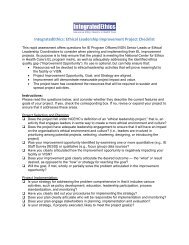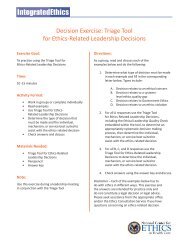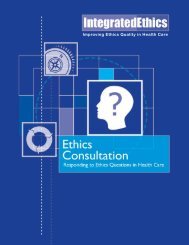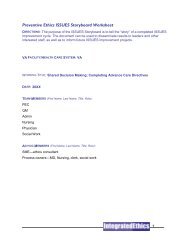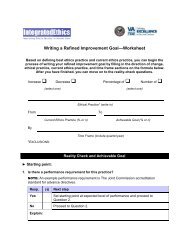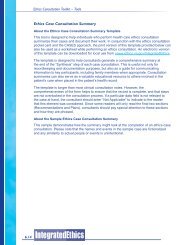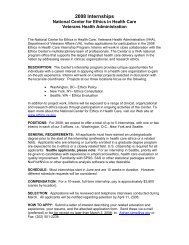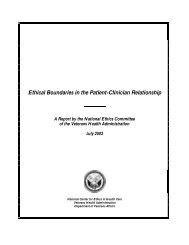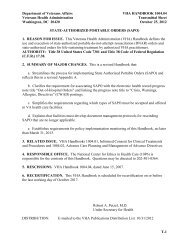Preventive Ethics - National Center for Ethics in Health Care - US ...
Preventive Ethics - National Center for Ethics in Health Care - US ...
Preventive Ethics - National Center for Ethics in Health Care - US ...
You also want an ePaper? Increase the reach of your titles
YUMPU automatically turns print PDFs into web optimized ePapers that Google loves.
Part III: ISSUES—A Step-by-Step Approach to <strong>Preventive</strong> <strong>Ethics</strong><br />
especially data that is <strong>in</strong> any way identifiable. The team should take the same precautions<br />
it would take to protect other types of quality improvement data.[50]<br />
Questions that are potentially useful <strong>in</strong> understand<strong>in</strong>g and diagramm<strong>in</strong>g the process<br />
<strong>in</strong>clude:<br />
• What are the scope and boundaries of the practice?<br />
• What is the actual flow of the process beh<strong>in</strong>d the practice?<br />
• Who is <strong>in</strong>volved <strong>in</strong> each step of the process?<br />
• Who else is directly or <strong>in</strong>directly affected by it?<br />
• How do the steps relate to each other?<br />
• Does everyone generally approach the process <strong>in</strong> the same fashion, or does each<br />
person, service, or unit do it differently?<br />
• Do exist<strong>in</strong>g standards (e.g., policies or operat<strong>in</strong>g procedures) def<strong>in</strong>e how the<br />
practice should be per<strong>for</strong>med?<br />
• Do staff members adhere to those standards?<br />
• Are there unwritten “rules” that conflict with the <strong>for</strong>mal standards?<br />
• What really happens on a day-to-day basis?<br />
With <strong>in</strong><strong>for</strong>mation from various sources <strong>in</strong> hand, the team should draw and label a process<br />
flow diagram. A variety of different <strong>for</strong>mats can be used. See Figure 4 (below) <strong>for</strong> an<br />
example of a process flow diagram illustrat<strong>in</strong>g how potential surrogates are identified<br />
dur<strong>in</strong>g the admissions process at one VA facility.<br />
Gather specific data about best practices<br />
Next, it’s important <strong>for</strong> the preventive ethics team to gather <strong>in</strong><strong>for</strong>mation about best<br />
practices to establish a clear picture of how the status quo needs to be changed. The<br />
team should use a comb<strong>in</strong>ation of published sources, expert advice, and (as needed)<br />
ethical analysis to develop a description of best practices that will serve as a goal of the<br />
improvement process.<br />
The team members should beg<strong>in</strong> gather<strong>in</strong>g <strong>in</strong><strong>for</strong>mation on best practices by familiariz<strong>in</strong>g<br />
themselves with available ethics knowledge (otherwise known as “best th<strong>in</strong>k<strong>in</strong>g”[51])<br />
relevant to the issue they’ve chosen to address. This could <strong>in</strong>clude ethics standards and<br />
guidel<strong>in</strong>es, consensus statements, scholarly publications, precedent cases, and applicable<br />
<strong>in</strong>stitutional policy and law. The team should generally review journals, texts, and onl<strong>in</strong>e<br />
resources on ethics <strong>in</strong> health care organizations. In addition, it may be helpful to exam<strong>in</strong>e<br />
codes of ethics <strong>for</strong> relevant professional groups, such as social workers, physicians,<br />
researchers, health care executives, or account<strong>in</strong>g professionals. Team members should<br />
also be sure they are familiar with applicable local and national VA policy. Reports from<br />
national commissions, the Institute of Medic<strong>in</strong>e, the American College of <strong>Health</strong>care<br />
Executives, or other learned bodies may be useful as well. The goal is to understand and<br />
to develop a well-grounded description of what would constitute ethics “best practice” and<br />
to identify potential pitfalls to avoid <strong>in</strong> implement<strong>in</strong>g change.<br />
The preventive ethics team should also seek examples of practices from other sett<strong>in</strong>gs<br />
that could be adapted to fit local circumstances. Staff at other VA facilities who have faced<br />
similar issues may be able to offer helpful suggestions about lessons learned. When<br />
39



